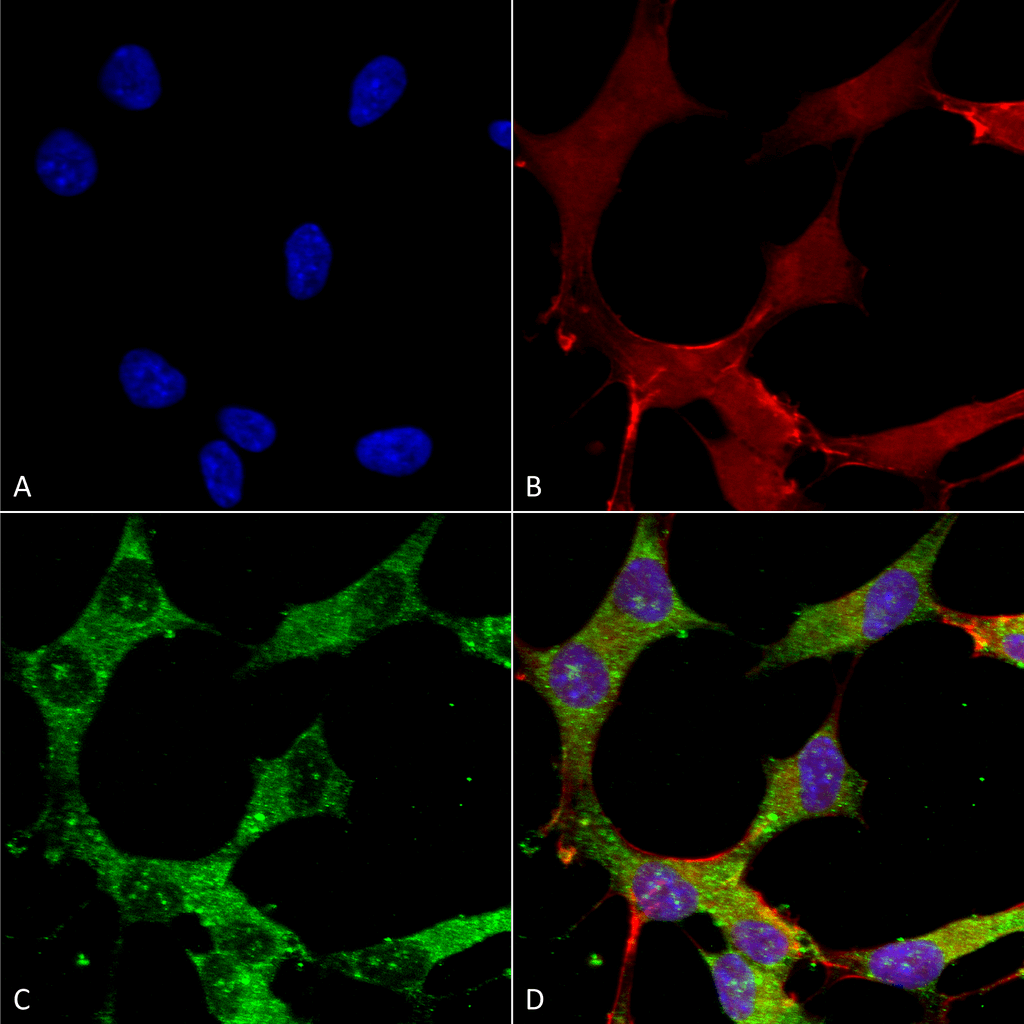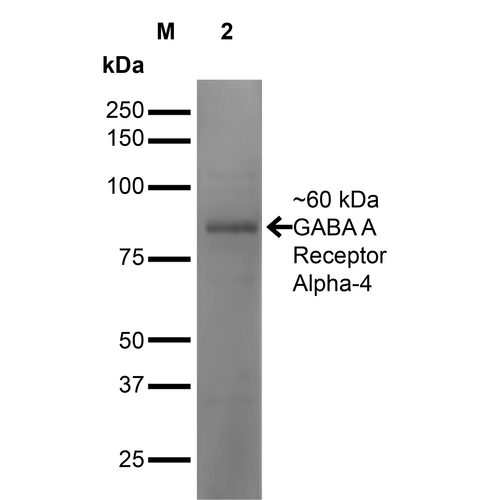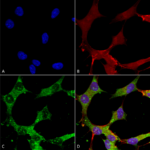Properties
| Storage Buffer | PBS pH7.4, 50% glycerol, 0.1% sodium azide *Storage buffer may change when conjugated |
| Storage Temperature | -20ºC, Conjugated antibodies should be stored according to the product label |
| Shipping Temperature | Blue Ice or 4ºC |
| Purification | Protein G Purified |
| Clonality | Monoclonal |
| Clone Number | N398A/34 (Formerly sold as S398A-34) |
| Isotype | IgG1 |
| Specificity | Detects ~60kDa. Does not cross-react with other GABA-A-Receptor Alpha subunits. |
| Cite This Product | StressMarq Biosciences Cat# SMC-489, RRID: AB_2702513 |
| Certificate of Analysis | A 1:100 dilution of SMC-489 was sufficient for detection of GABA-A R, Alpha4 in 20 µg of mouse brain lysate by ECL immunoblot analysis using Goat anti-mouse IgG:HRP as the secondary antibody. |
Biological Description
| Alternative Names | GABA A receptor subunit alpha 4 Antibody, GABRA4 Antibody, Gamma aminobutyric acid A receptor Alpha 4 Antibody |
| Research Areas | GABA Receptors, GABAA Receptors, Neuroscience, Neurotransmitter Receptors |
| Cellular Localization | Cell Junction, Cell membrane, Postsynaptic cell membrane, Synapse |
| Accession Number | NP_542154.3 |
| Gene ID | 140675 |
| Swiss Prot | P28471 |
| Scientific Background | The GABA-A receptor is a member of the superfamily of fast acting ligand-gated ion channels. The individual subunits of these receptors have similar sequences and structural features (1). GABA-A receptors are the major fast inhibitory neurotransmitter gated ion channels in the brain (2). GABA-A Receptor Alpha 4 is associated with epilepsy (3), and research suggests that alterations in GABA- A Receptors subtypes may be involved in the resistance to antiepileptic drugs (4). |
| References |
1. Bracamontes J.R. and Steinbach J.H. (2008) J Bio Chem. 283: 26128-26136. 2. Macdonald R.L., Olsen R.W. (1993) Annu Rev Neurosci. 17: 569-602. 3. Grabenstatter H.L., et al. (2014) Epilepsia. 55(11): 1826-1833. 4. Bethmann K., Fritschy J.M., Brandt C., Loscher W. (2008) Neurbiol Dis. 31(2): 169-187. |
Product Images

Immunocytochemistry/Immunofluorescence analysis using Mouse Anti-GABA-A Receptor Alpha 4 Monoclonal Antibody, Clone N398A/34 (SMC-489). Tissue: Neuroblastoma cells (SH-SY5Y). Species: Human. Fixation: 4% PFA for 15 min. Primary Antibody: Mouse Anti-GABA-A Receptor Alpha 4 Monoclonal Antibody (SMC-489) at 1:50 for overnight at 4°C with slow rocking. Secondary Antibody: AlexaFluor 488 at 1:1000 for 1 hour at RT. Counterstain: Phalloidin-iFluor 647 (red) F-Actin stain; Hoechst (blue) nuclear stain at 1:800, 1.6mM for 20 min at RT. (A) Hoechst (blue) nuclear stain. (B) Phalloidin-iFluor 647 (red) F-Actin stain. (C) GABA-A Receptor Alpha 4 Antibody (D) Composite.

Immunocytochemistry/Immunofluorescence analysis using Mouse Anti-GABA-A Receptor Alpha4 Monoclonal Antibody, Clone N398A/34 (SMC-489). Tissue: Neuroblastoma cell line (SK-N-BE). Species: Human. Fixation: 4% Formaldehyde for 15 min at RT. Primary Antibody: Mouse Anti-GABA-A Receptor Alpha4 Monoclonal Antibody (SMC-489) at 1:100 for 60 min at RT. Secondary Antibody: Goat Anti-Mouse ATTO 488 at 1:100 for 60 min at RT. Counterstain: Phalloidin Texas Red F-Actin stain; DAPI (blue) nuclear stain at 1:1000, 1:5000 for 60min RT, 5min RT. Localization: Cytoplasm. Magnification: 60X. (A) DAPI (blue) nuclear stain. (B) Phalloidin Texas Red F-Actin stain. (C) GABA-A Receptor Alpha4 Antibody. (D) Composite.

Western Blot analysis of Mouse Brain showing detection of ~60 kDa GABA-A-Receptor-Alpha4 protein using Mouse Anti-GABA-A-Receptor-Alpha4 Monoclonal Antibody, Clone N398A/34 (SMC-489). Lane 1: MW Ladder. Lane 2: Mouse Brain. Load: 20 µg. Block: 2% GE Healthcare Blocker for 1 hour at RT. Primary Antibody: Mouse Anti-GABA-A-Receptor-Alpha4 Monoclonal Antibody (SMC-489) at 1:1000 for 16 hours at 4°C. Secondary Antibody: Goat Anti-Mouse IgG: HRP at 1:200 for 1 hour at RT. Color Development: ECL solution for 6 min at RT. Predicted/Observed Size: ~60 kDa.






















StressMarq Biosciences :
Based on validation through cited publications.